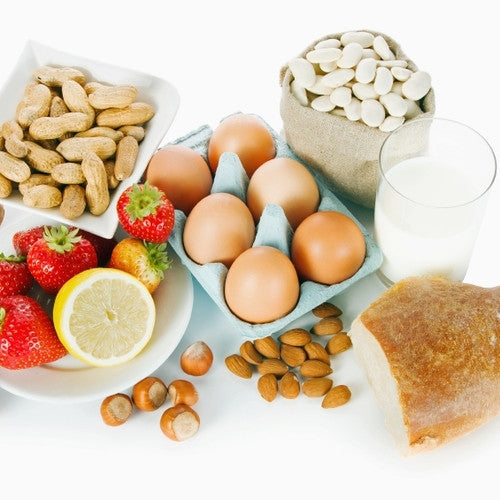

Feeding toddlers with food allergies
According to the CDS, food allergies within children are on the rise, and with that we need to prepare ourselves to give our child a nutritious allergen free diet. With food allergies among children up 50% from 1997 to 2011, it is becoming more and more common to have to work around different foods in your young one’s diet. Below we’ve listed some of the more common food allergies in young children and some general tips and tricks.
Milk Allergy
Milk is one of the most common food allergies in young child, and sadly, one of the most difficult to work around. Milk provides a good source of many important nutrients essential for bone mineralization and growth such as protein, calcium, vitamin D, vitamin A, vitamin B12, riboflavin and phosphorus.. In order for your child to replace these nutrients you must carefully choose food substitutes. Meats, poultry, eggs, fish, nuts, and legumes all provide a good source of protein. To replace the calcium we recommend searching for specific foods that are fortified with calcium or considering giving your child supplements. The good news is that many children grow out of this allergy at a young age with many losing it by the age of 2.
Soy Allergy
Soybeans provide one of the highest quality proteins in a child’s diet as well as thiamin, riboflavin, iron, phosphorus, magnesium, calcium, zinc, and vitamin B6. A soy-restricted diet should not pose a nutritional problem if your child eats a variety of fruits, vegetables, enriched and fortified grains, and tolerated sources of protein.
Egg Allergy
Children with egg allergy must avoid egg in all forms, unless specifically told otherwise by an allergen specialist. Eggs can provide a good source of quality protein as well as iron, biotin, folacin, pantothenic acid, riboflavin, selenium, and vitamins A, D, E and B12. While there are many other good sources for protein, it can be hard to get all your child’s needed calories without baked goods. There are many recipes for baked goods with egg substitutes so feel free to experiment and see what your child likes. Above all be sure to avoid all contact with eggs and make sure your child is getting enough calories every day.
Fish Allergy
Fish typically is a good source of protein, niacin, phosphorus, selenium, magnesium, iron, zinc, and vitamins B6, B12, A and E. If your child has to avoid fish, you can find all the same nutrients in other sources of protein such as meats, grains, and legumes.
Peanut or Tree Nut Allergy
While nuts are a good source of protein, having to avoid them does not put your child at much of a nutritional risk. Nuts can very easily be replaced by a variety of other food groups to provide plenty of protein in your child’s diet.
Wheat Allergy
Wheat is a grain that you can replace with other grains. Other grains like corn, rice, barley, buckwheat and oats can be used to replace wheat, but you have to be careful about your selections. One common concern with grains is cross contact with wheat. To avoid this be sure to choose alternate grains from a reputable source. Wheat is also often fortified with extra nutrients, so make sure to choose fortified or enriched grains to provide your young one with plenty of B vitamins, folacin, and iron. When cooking, you can also often replace wheat flour with other fortified grain flours to provide the same nutrients.
